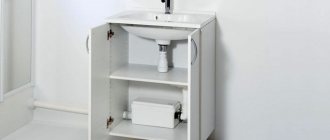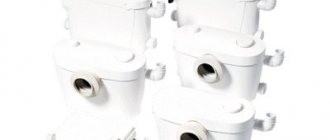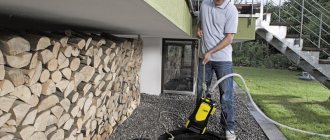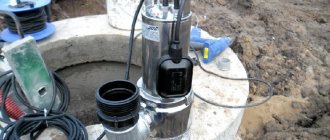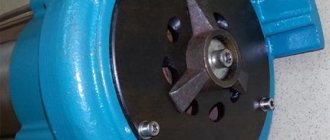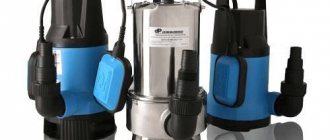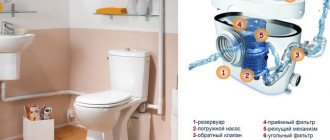A sewer pump in an apartment for the kitchen is installed to increase the pressure of waste liquids and force them to drain into the sewer. It also performs other functions, such as preventing pipeline clogging.
There are several types of pumping equipment, each of them has certain features and technical characteristics.
You can carry out the installation yourself, but before doing this you need to select the right equipment and study the installation instructions. For long-term operation, you must adhere to the operating rules of the device.
Device and purpose
A pump with a grinder is a surface sewer pumping installation that allows you to organize the removal of wastewater where it is not possible to do this using a gravity system. This is a small plastic container with a powerful built-in pump that pumps waste into the sewer. The movement of drains can be both vertical and horizontal. There are installations with a grinder that can be connected to toilets, and there are those without a grinder - for “gray” waste from sinks, showers, bidets, etc.
The sewer pump for toilets and other plumbing fixtures is small in size
Application area
A sewer pump is used in cases where it is impossible to create a gravity sewer system. In most cases, when a plumbing fixture, washing machine or dishwasher is installed below the entrance to the sewer. This is why forced sewage pumps were invented. This solution allows you to move bathrooms and technical rooms to basements or semi-basements.
You can connect sanitary pumps in the bathroom, toilet, kitchen, and laundry room. In any room where water drainage is required and the sewer drain is far away
A pump with a grinder is also installed if it is decided to build a bathroom after the renovation is completed and the sewerage system is not connected to the place where the plumbing is supposed to be installed. In this case, the installed equipment is connected to a compact sewage pump, and it is connected to the sewer. What is the difference? In the following:
- the diameter of the outlet pipes for the sewer pump is much smaller than for the gravity system (28-40 mm);
- drains can rise up to a height of up to 9 meters;
- horizontal wastewater disposal is possible up to 100 meters (requires a minimum slope of 1-4%).
All this allows you to organize a connection to an existing sewer system almost anywhere at minimal cost.
Design and principle of operation
The sewage pump consists of a plastic storage container and a pump. Some models that can be connected to a toilet have a grinder. The filling level is controlled by a sensor. When it is triggered, the grinder and pump are turned on, and wastewater is pumped into the sewer system. The shutdown is controlled by a second sensor - it turns off the power when the wastewater level drops below a certain level. This is a simplified algorithm for the operation of pressure sewerage.
Sewage pump with grinder: device
There are sewage pumping stations designed to connect devices of various types and quantities. The simplest one is designed to connect one or two devices, the most productive one has three additional pipes (and one main one). Accordingly, the container has one or more inlet holes (depending on the model) and one outlet hole. Pipes coming from the plumbing are connected to the inlets, and the outlet is connected to the sewer.
For pumping out high-temperature wastewater from washing machines, dishwashers, and bathtubs, there are special models made of heat-resistant materials. A conventional sewage pump cannot cope with such a load. Therefore, to connect such equipment you need to look for certain models.
Sewage pump for the kitchen: which one to choose?
I strongly advise you to purchase models for your kitchen that are specifically designed for this purpose.
Models suitable for showers will not work in the kitchen for long. In addition, you will lose the service center warranty.
I won’t give any specific advice about the manufacturer. But remember that in this case the service life is directly proportional to the price.
A cheap Chinese station most likely will not please you with a long life. That's all for now, write questions in the comments and read our blog!
Advantages and disadvantages
The main advantage of compact individual sewerage installations is that they allow you to equip a sewerage system without carrying out large-scale construction or repair work. With their help, complex problems are solved:
- Drainage arrangement when plumbing fixtures are located below the entry point into the sewer system.
- Equipping a bathroom without carrying out large-scale civil works.
Another positive point is the use of small diameter pipes. Most toilet pumps are connected to the sewer using plastic pipes with a diameter of 28 mm - 32 mm - 40 mm. Only high-capacity installations require the installation of 50 mm pipes. Such plumbing networks are easier to hide. Even if it was not possible to hide them, they do not attract as much attention as the standard one hundred millimeter ones.
Examples of sewage pumps for toilets and bathrooms
However, there are also disadvantages:
- Dependence on electricity. No power - sewerage doesn't work. A redundant source is required for uninterrupted operation.
- The pumps are noisy. Manufacturers are improving their products, installing pumps with lower noise levels, but they are still present.
- Compliance with certain operating rules is required. For example, it is undesirable for fibrous materials to enter the shredder. Modern shredders cope well with toilet paper, but with fibrous components and hair they are a problem. They wrap around the screw, reducing the quality of chopping. Sooner or later the screw gets blocked. An installed overheat sensor will not allow the equipment to burn out - it will turn it off earlier. But the installation will have to be disassembled and cleaned, and this is not the most pleasant task.
There are compact models for installation in niches
Well, the main drawback is that the pumps burn out. If the power and performance are selected correctly, unsuitable objects do not fall into the sewer, and they can work for years. But if there is a selection error, when the equipment is operated to the limit, the pumps often fail. Therefore, when choosing a sewer pump for a toilet, it is better to choose one with a margin of performance. It will cost more, but this installation will last longer.
What to look for when purchasing?
Not a single company selling household pumps will sell products that are known to be of low quality. This is fraught with consequences such as conflicts with consumers, repairs at the expense of the company and additional costs. And most importantly, the company's image will suffer.
The level of pumps produced is quite high, with rare exceptions. Companies selling such units exclude from their assortment those products that have not proven themselves well in the market.
Cheap and high-quality pumps from European or domestic manufacturers are not sold on the modern market. Therefore, when choosing, you should always take this nuance into account. When purchasing, you should also check the fittings and connections , and before connecting the device, it is advisable to read the instructions.
Classification and types
There is no single classification of forced sewer installations, but they can be divided according to several parameters:
- Presence of a chopper. It is needed if the sewer pump is connected to the toilet.
- Performance. This is the volume of wastewater that can be pumped per unit time. There are installations with low productivity and even very solid ones. The choice depends on the number and type of connected devices.
- The temperature of the pumped medium is from 40°C to 90°C. Everything is clear here - drains from a dishwasher, washing machine, and bathtubs require sewer pumping stations capable of pumping wastewater at high temperatures.
- Duration of work. There are installations that can only be turned on for a short time (they are installed on one or two devices), and there are more “long-lasting” ones (can be used to drain the wastewater of an entire house). This is usually indicated in the specifications as the duration of operation. The percentage may be 50%. This means that the installation works for 30 seconds and rests for 30 seconds. The operation/cooling interval can be specified in seconds or minutes.
Sewage pump for shower - with installation under the tray
When choosing a pump for forced sewerage, it is worth remembering that they are not designed to connect a bathtub. Bathrooms contain too much water, pumping out which will cause the pump to overheat and block. As a result, it will take a long time to drain the water from the bathroom. There are only a few models of forced sewerage that will cope with this task - SFA Saniplus Silence and Sololift C3. These sewer pumps do a great job of discharging large amounts of warm water.
Other companies propose to make an intermediate pit for forced pumping of drainage from the bathroom into which to drain the water. From it, pump it into the sewer using any suitable device. Taking into account the fact that the pit must be below the drainage level, this method is not always acceptable. And, despite the high cost of SFA Saniplus Silence and Sololift C3, it is often more profitable to install it than to carry out a huge amount of excavation work.
To prevent the tank from overfilling there is an additional alarm device. In some companies it simply beeps when the container is full, in others it also turns off the device connected through it (washing machine or dishwasher).
What are they for?
The need to install this equipment in an apartment can be caused by several factors, namely the redevelopment of simple city apartments. Sometimes, to create a comfortable space, it is necessary to move the bathroom and toilet to the center of the apartment.
Sometimes the kitchen must be moved from one room to another , so that the dishwasher and sink are next to the sewer riser. In this case, the pipeline will have to be broken, and this is fraught with the formation of blockages.
In addition, a new route will have to be laid for the pipe , which may run through the hallway or room. This is unacceptable. Sewage pumps for apartments can successfully solve such problems.
Installation and connection rules
The installation and connection of toilet pumps and forced drainage from different manufacturers follows very similar rules. But before installation, you should read the instructions for a specific product - there may be special features.
A sewer pump can be installed in the kitchen to remove waste from the sink and/or dishwasher.
Connection
The installation location must be chosen in such a way that the pump can be reached. It does not require special maintenance, but there is a need for cleaning from time to time. If a dishwasher and washing machine are connected to the pump, it is better to regularly check whether the sewage system is clogged with grease, dirt, and salt deposits. If necessary, cleaning with mild detergents is possible. It is better not to use aggressive chemical compounds, as they can damage the plastic and rubber parts of the installation.
If the sewer inlet is higher than necessary
So here are the general rules:
- An individual sewer installation must be grounded. Therefore, the outlet must be three-wire with a working ground. (We read about the installation of a ground loop in a private house here).
- For safety, there must be a circuit breaker and an RCD on the power supply line.
- During installation, the block is fixed to the floor. To reduce the noise level, it is advisable to install it on a vibration-damping base (rubber gasket). It is not advisable to press the housing against the wall so as not to transmit vibration from the pump. These measures are needed to reduce noise levels. A sewer pump can be installed in the kitchen to remove waste from the sink and/or dishwasher.
- The exhaust pipeline is made of rigid plumbing pipes. There are two recommended options - plastic sewer pipes and copper pipes. Fittings are recommended to be rigid and one-piece.
- Pipelines must be fixedly fixed (to walls, floor, etc.).
In general, installing and connecting a sewer pump for a kitchen or toilet is not a very difficult undertaking. But provided that you already have some idea about working with plumbing. In this case, you can do everything yourself.
Features of the outlet pipeline
Compact plumbing pumps for the toilet can pump wastewater not only vertically, but can also lift it upward. If there is a vertical section in its lower part, it is advisable to provide for the possibility of draining - if you have to clear the pipeline from a blockage, it is better if the drains are drained in a certain place and do not start pouring out during work.
The height of the vertical section of the outlet pipeline is determined taking into account the minimum slope of the horizontal section. Each manufacturer (sometimes each model) has its own minimum slope, but in most cases it is 1-4% (1-4 cm per 1 meter).
Rules for installing a sewage pump
Be careful. The description of sewage pumps indicates the maximum lifting height of wastewater and the maximum horizontal transportation distance. For example: 8 m up, and 80 m horizontally. But this does not mean that by lifting the pipe 4 meters up, it will be possible to transport another 80 meters horizontally. In this case - after a four-meter rise - the length of the horizontal section will be no more than 40 meters. Simply lifting 1 meter upward “takes away” about 10 meters of horizontal transportation. This is important and worth remembering.
Operating principle
Thanks to technological progress, mechanisms called sololifts have appeared, which crush masses of waste and forcefully transport them through pipes of smaller diameter. As a result, users have the opportunity to “move” plumbing fixtures away from the riser and even place them below the discharge level into the external sewer system, where wastewater cannot leave the basement by gravity. The movement of waste is carried out forcibly, for which special electric fecal pumps are used - sololifts.
Manufacturers and models
Not many companies produce individual sewerage installations. However, the price range is quite wide. Traditionally, European manufacturers are distinguished by good quality, but high prices. No one will be surprised if we say that Chinese sewage pumps cost less, but their quality is worse. In general, the choice, as usual, is expensive and high quality, or cheaper and...
Forced sewerage installations Grundfos (Grundfos) - Sololift (Sololift)
The well-known manufacturer of plumbing fixtures Grundfos produces Sololift pumps for forced sewerage. At the moment, a modified Sololift2 line has been launched. There are no moving parts in contact with drains. The exception is the chopper, but its drive is also “dry”. This makes repairs less of a hassle. There are several Sololift models for different cases:
- WC1 - with a chopper, one main and one additional input. Suitable for connecting toilet and washbasin.
- WC3 is a pump with a grinder for connecting a toilet and three additional inlets.
- CWC3 - the same as WC3, only for connecting wall-hung toilets.
Main characteristics of Sololift sewage pumps - C3 is a high-capacity fecal pump that can pump out wastewater with temperatures up to +90°C, pump wastewater from a bathtub, from a washing machine and/or dishwasher.
- D2 - pump for hot wastewater (with temperatures up to +90°C) without solid impurities. It can be connected to a shower, washbasin, washing machines and dishwashers.
Sololift sewer pumps are not the cheapest equipment, but they work reliably and meet the stated characteristics. The company also supports warranty repairs.
Pumps for toilets, bathrooms, kitchens and technical rooms SFA
This company specializes in the production of sanitary pumps. There are several lines to solve different problems and connect various devices:
- Saniaccess is a household pump grinder for a toilet with the ability to connect a washbasin and shower (modifications with numbers 2 and 3, respectively). Has low productivity.
- Sanibest is a high-performance toilet and sewer pump. Suitable for private homes with high intensity of use and for public spaces.
- SANIBROYEUR is a silent toilet pump, has a grinder, and can transport wastewater 4 m up or 100 m to the side.
Dimensions SFA SANIBEST Pro - Sanipack is a compact sewer pump to which you can connect a wall-hung toilet and a shower/sink/bidet. Can be built into a partition due to its small size.
- Saniplus Silence is a powerful pump that can remove water from several plumbing fixtures. It features low noise operation and high productivity. Can handle bathroom drainage.
- Sanipro XR Silence is the quietest model for pumping sewage from a full bathroom (without a bathtub).
- SaniTop - installation of forced sewerage for connecting a toilet and sink. This newer model is quieter compared to Saniaccess and has a more powerful pump.
SFA products work reliably and cost slightly less than Grundfus. You can choose a model for any combination of plumbing fixtures. Overall, the SFA sewage pump is a good option. Equipment installation is standard - place it in any convenient place. There is only one limitation - it is better for the outlet pipeline to start from a vertical section, if there is one on your route. If this is not possible, the length of the horizontal section should be no more than 30 cm.
The height of the vertical section is calculated taking into account that the horizontal section must have a slope towards the inlet of at least 1% (1 cm per 1 meter of pipe).
CompactLift fecal pumps from Aquatik
Toilet pumps Compact Lift are produced by the Chinese company Aquatic. This is a more budget-friendly option for individual sewer installations. They have a low noise level.
At the moment there are only three modifications:
- Compact LIFT 250. Installation for pumping out gray waste (without feces and toilet paper). A low power of 250 W and a flow rate of 119 liters/min allows you to connect a shower and sink.
Sewage pump Aquatik Compact LIFT - Aquatik Compact LIFT 400. Compact sewage pump with the ability to connect a toilet with direct outlet and three additional plumbing fixtures. Power - 400 W, productivity 149 liters/min.
- Aquatik Compact LIFT 400 A. For connecting wall-hung toilets. The technical specifications are similar. series
Aquatik provides a warranty on its pumps for bathrooms and toilets for 1 year from the date of sale. Failure to operate (presence of fibrous inclusions in drains) may result in refusal of warranty repair.
Willo sewage pumps
The German company Willo is known for producing reliable devices. Toilet pumps are no exception. Good quality plastic, thick tank walls, reliable pump. The following models are available:
- HiDrainlift 3-24 - for servicing clean drains without feces and toilet paper (shower, washbasin, urinal). Power 300 W, flow rate 58 liters/min.
- HiDrainlift 3-25 is a pump for connecting a toilet with direct outlet and three additional pipes for connecting a shower, washbasin, etc. Power 400 W, maximum productivity 100 liters/min.
- HiSewlift 3-15 - for connecting one floor-standing toilet. Plus has one additional input for connecting a washbasin/shower/urinal/bidet. Power 450 W, maximum flow 75 liters/min.
Dimensions of one Willo bath pump model - HiSewlift 3-35 - one input for pumping out toilet drains and three inputs for connecting devices with gray waste - washbasin/bidet/urinal/shower. Power consumption 450 W, capacity 75 liters/min.
- HiSewlift 3-I35. More compact installation with parameters similar to HiSewlift 3-35.
- DrainLift KH 32. For connecting a wall-hung toilet, equipped with three additional pipes for connecting plumbing equipment with clean drains. Power consumption 450 W, can pump out no more than 75 liters/min.
- DrainLift XS-F - similar to DrainLift KH 32, but smaller in size, for installation in a wall niche.
- DrainLift TMP 32. For connecting gray drains - without faeces and toilet paper. There are two outlets to which you can connect washing machines or dishwashers.
Characteristics of three models of Willo sewage pumps - DrainLift TMP 40. For pumping domestic wastewater (without faeces). It can be connected to the kitchen - it is possible to supply drains from the sink and dishwasher. It differs from all models in the standard configuration - it has a float switch that will turn off the dishwasher pump if there are signs of overfilling of the tank.
The Willo range of sewer pumping units allows you to solve any problem when it comes to equipping bathrooms and toilet rooms in private homes. For commercial or more intensive use, Willo has other solutions.
Pressure sewage pumps STP (Jemix)
These custom sewer installations are manufactured in China. The price category is average. Reviews, as usual, are different - some are completely satisfied, others categorically dislike it.
So, here are the sewerage pumps Jemix offers:
- STP-100 Lux. For connecting a toilet with two additional inputs (washbasin, urinal, shower). Power 600 W, productivity 200 liters/min, vertical lift height - 9 m, horizontal lift - 90 m, maximum temperature +90°C.
- STP-400 Lux. Toilet pump with similar connection options. Only the wastewater temperature is not higher than +40°C, power 400 W, productivity 100 liters/min, wastewater lifting height - up to 8 meters, horizontal transportation - up to 80 m.
Approximate prices for sewage pumps STP (Jemix) - STP-800. You can also connect one floor-standing toilet + two additional inputs. But the power is 800 W, the pressure is 150 liters/min, the lift is 9 m, horizontally - 90 m. Only warm waste can be transported - up to +40°C.
- STP-200. With one input for connecting a toilet and two additional ones. Less power - 400 W, can pump out 100 liters/min, maximum height - 8 m, horizontal transportation - 80 m, temperature of the transported medium is not higher than +40°C.
- STP-250. For drainage of gray waste (without solids). It has two entrances (shower, washbasin, bidet). Power 250 W, drainage lifting height up to 5 m, horizontal transportation no further than 50 m, can pump out no more than 80 liters/min.
- STP-500 Lux. This pump is for toilet use only. No additional outputs
It differs from those described above in its increased power - some models raise drains by 9 meters. Most of the sewerage pressure pumps described above can lift wastewater up to 4-5 meters. So this is where the Jamicks win. In this parameter they have only one competitor - Sololift Grundfos with its lifting height of 8 meters. But its price category is completely different (as is its quality, for that matter).
Varieties
Currently, there are several types of plumbing fixtures on sale for pumping sewage water from the kitchen.
Location of the sewage pump in the kitchen
These include:
- Stationary pumps. They are containers designed to be installed in a place convenient for the user. Usually installed outside the kitchen. They provide pumping of large volumes of wastewater over long distances. As a rule, they are installed extremely rarely in apartments.
- Sanitary sewerage stations. This term usually refers to devices to which several household appliances can be connected. Such pumps are not suitable for pumping liquids with a large amount of contaminants due to the lack of grinders in their design. Suitable for working with sewage water with an operating temperature of 35-45 degrees.
- Forced sewerage stations. This type of pumping device is best suited for the kitchen. The pump consists of a compact, completely sealed housing that prevents unpleasant odors from spreading from the sewer into the room. Also, this kitchen plumbing pump can be equipped with a device for grinding solid particles present in the drains. It is characterized by high performance and reliability, equipped with an automatic operation function.
Note: Most household kitchen pumps do not have a cutting mechanism. Units with a grinder are usually installed in the bathroom, where such an option is more necessary due to the nature of the wastewater.
Automatic operation
Operating pumping equipment manually is quite inconvenient, since it will need to be constantly turned on and off, which means you need to be near the unit.
It is much better when the pump comes with:
- A float
is an element that determines the level of waste in the storage tank and the need to turn the device on or off. - Thermal relay
is a part that is activated when the temperature of the electric motor rises to a critical level and prevents it from overheating by turning it off.
Some manufacturers of sewage pumps with a built-in grinder include the ability to self-clean its cutting mechanism, which increases the life of the unit without stopping for maintenance and reduces the likelihood that the electric motor will overheat.
Working environment temperature
When installing a household sewerage system with a pump, equipment of two categories is used:
- For cold waste liquids whose temperature does not exceed 45 degrees.
- For hot wastewater with an operating temperature of up to 90 degrees.
If you plan to send only cold water to the sewer, then it is better to purchase the first pump option, since it is cheaper. Most often, such units are installed in country cottages. A liquid with a temperature of more than 100 degrees can enter the sewer system of a private house only in the event of an emergency discharge from the heating system.
